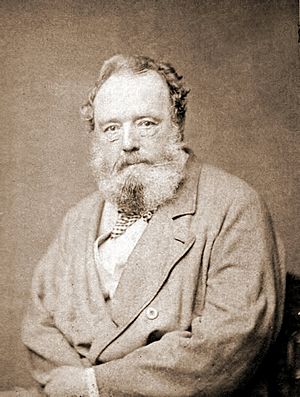Edwin Lankester facts for kids
Edwin Lankester (born April 23, 1814 – died October 30, 1874) was an English surgeon and naturalist. He played a very important role in helping to control cholera outbreaks in London. He was also the first public analyst in England, which meant he checked things like food and water for safety.
Contents
Early Life and Family
Edwin Lankester was born in 1814 in Melton, a small town near Woodbridge in Suffolk, England. His parents were not wealthy but were very smart. His father worked as a builder.
In 1845, Edwin married Phebe Pope. She was 19 years old at the time. Phebe became a well-known botanist (someone who studies plants) and microscopist (someone who uses microscopes). She even wrote books for children and articles about nature!
Edwin and Phebe had eleven children, but sadly, only eight of them lived to adulthood. Four were boys and four were girls. A famous scientist named Thomas Henry Huxley was a close friend of their family and visited often. John Stevens Henslow, who was Charles Darwin's teacher, was also a family friend. He helped Edwin's son, Ray, get interested in collecting fossils.
One of Edwin's sons, E. Ray Lankester, later became a very famous biologist. Edwin wanted his sons to be great scientists.
His Career and Discoveries
Edwin Lankester first learned about medicine by working with a surgeon in Woodbridge. Later, he studied medicine and science at the new University College London from 1834 to 1837. He learned from important professors like John Lindley (botany) and Robert Edmund Grant (zoology).
He became a qualified surgeon and apothecary (a type of pharmacist and doctor). In 1839, he traveled to Heidelberg in Germany to get his medical degree (M.D.).
Back in London, Edwin became very interested in natural history. He wrote articles about plants, medicine, and surgery for different journals.
He made important studies, like looking at tiny bacteria found in sulfur water. He also used microscopes to examine drinking water. His book The Aquavivarium (1856) was very popular. He also helped start an important science journal called the Quarterly Journal of Microscopical Science in 1853. Another one of his books, Half-hours with the microscope (1857), was a huge success and was printed many times.
In 1845, a type of flowering plant from Africa was named Lankesteria in his honor. This shows how respected he was in the world of botany.
Edwin Lankester was also the President of the British Association for 25 years. He was the first Secretary of the Ray Society, and his wife, Phebe, was the Assistant Secretary. He was also President of the Royal Microscopical Society and later the first President of the Quekett Microscopical Club. In 1845, he was chosen to be a Fellow of the Royal Society, which is a very high honor for a scientist.
He also served as a coroner for Central Middlesex, which meant he investigated deaths to find out their causes.
Fighting Cholera in London
Edwin Lankester played a key role in understanding and fighting cholera outbreaks in London. Cholera was a terrible disease that caused severe sickness and often death.
Other doctors, like John Sutherland and John Snow, had already suggested that cholera was spread through contaminated water. John Snow famously made a map showing how many cholera cases were near a specific water pump on Broad Street.
Lankester set up a special committee to investigate the latest cholera outbreak in 1854. The committee's report, which included sections written by John Snow, concluded that the outbreak was caused by dirty water from the well on Broad Street.
Even though many people didn't believe John Snow at first, the pump was eventually closed. After the pump was shut down, the number of new cholera cases quickly dropped.
Lankester later became the first Medical Officer of Health for the St. James's district, which was the area where the outbreak happened. It took many years for public officials to make sure that London's water supply was clean and safe. John Snow's work on how cholera spread was eventually recognized as one of the most important medical discoveries of the 19th century.
Lankester's interest in this problem came from his own work using microscopes to examine water. Even today, checking water with a microscope is an important way to make sure our drinking water is safe.
Selected Publications
- Lankester, Edwin. The Aquavivarium. 1856.
- Lankester, Edwin. Half-hours with the microscope. 1857.
Images for kids





